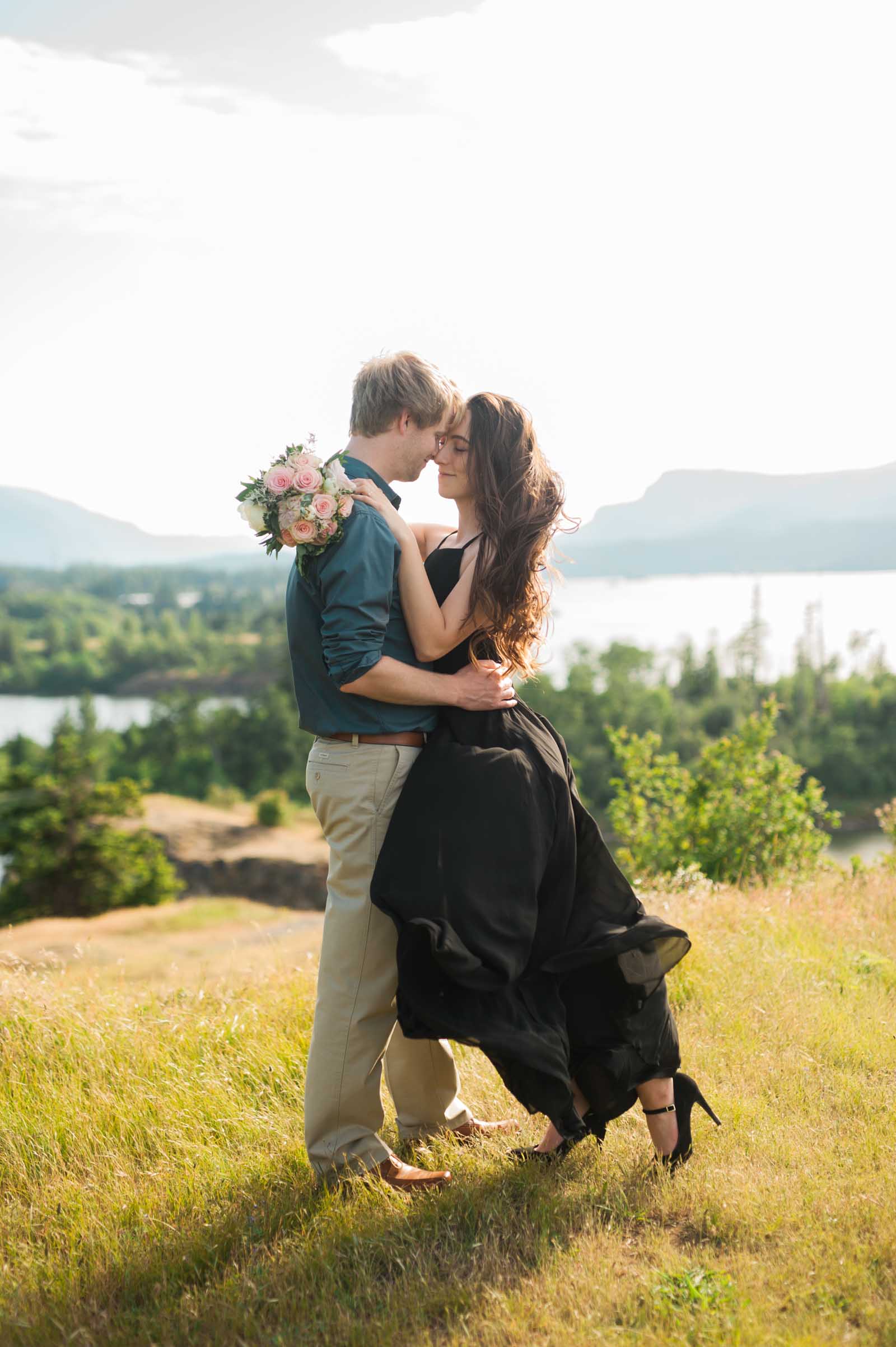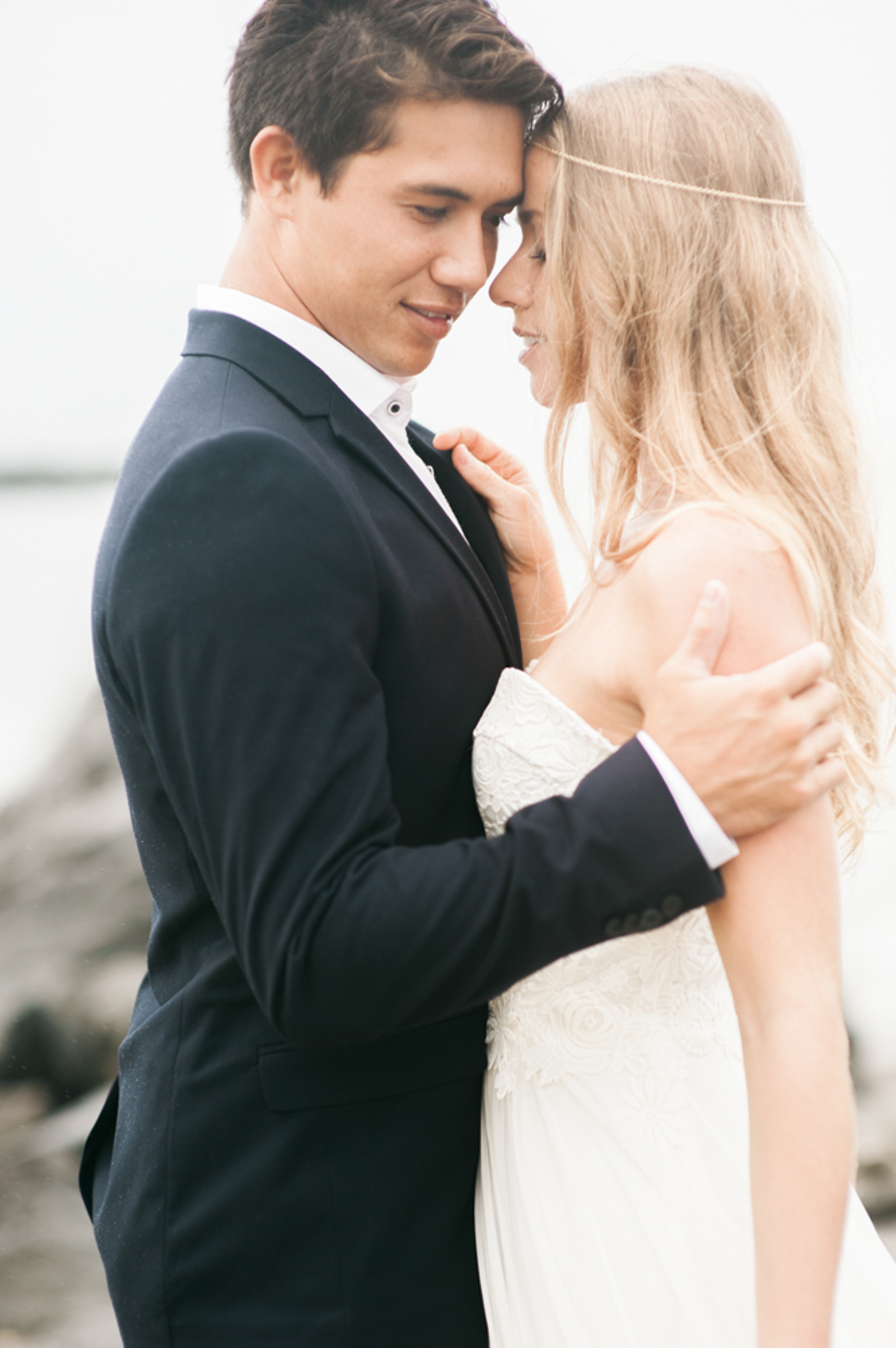Embarking on the journey to orchestrate your perfect day can seem overwhelming, but following a well-structured wedding planning checklist ensures that no detail escapes attention. Within this guide lies the secret to transforming your wedding planning journey into an enjoyable adventure. Begin by crafting a comprehensive wedding planning timeline, adhering to specific deadlines that keep you on track and reduce stress. Identifying and securing reliable wedding vendors early in the process is crucial; they are your partners in turning your vision into reality. Preserve these cherished moments with exceptional wedding photography, capturing your special day from every angle. This guide paves the way for a seamless, memorable celebration.
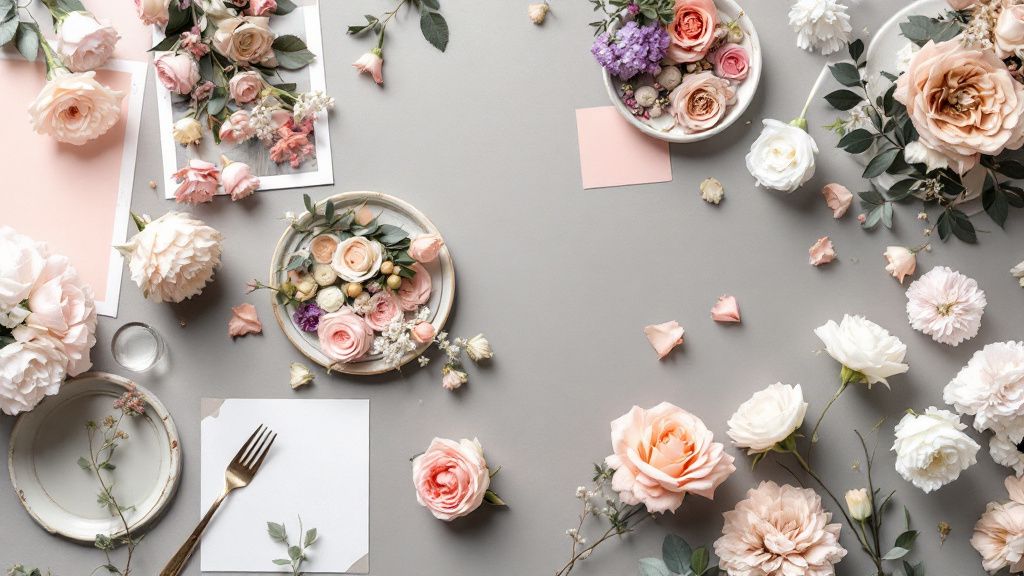
Choosing Your Wedding Theme
What role does selecting your wedding theme play in shaping the entire celebration? Choosing your wedding theme is a creative venture that touches every element of your big day, from color palettes to the overall mood. Consider how the theme mirrors your personalities and shared interests, creating a harmonious and cohesive experience for you and your guests. Whether you lean towards a classic, romantic ambiance or a modern, minimalist vibe, your theme sets the tone for everything else.
The next step is integrating this theme into your wedding planning checklist. Use the theme as a guide for decision-making, whether it involves selecting decor or narrowing down attire options for the wedding party. It acts like a compass, keeping your wedding planning timeline intact and ensuring that every piece aligns seamlessly. This consistency offers not only visual harmony but also emotional resonance as your vision comes to life.
Your wedding vendors play a critical role in executing your chosen theme. As you embark on the selection process, it’s vital to communicate your theme in detail to ensure they share your vision. These professionals are adept at incorporating your ideas, whether through floral arrangements, music, or culinary delights, guaranteeing an authentic reflection of your chosen theme. Their expertise can make your concept flourish in ways you had only imagined.
Incorporating your theme into wedding photography allows you to capture the essence of your celebration in every frame. Discuss your theme with your photographer to ensure they understand the atmosphere you aim to create. This collaboration will ensure that your photos tell the story of your wedding day with clarity and charm. From candid moments to posed shots, your theme should permeate through every image, creating a visual journey of your day.
A well-chosen wedding theme brings unity and vibrancy to your wedding day, transforming it into a cohesive celebration. It acts as the heartbeat of your event, influencing decisions and guiding the overall experience from beginning to end. By ensuring all elements align with your theme, you create an unforgettable and personalized event that resonates with everyone in attendance.

Setting a Realistic Budget
Setting a realistic budget is a crucial step in the wedding planning process that impacts every subsequent decision you make. Begin by determining how much you are willing and able to spend, categorizing each aspect of your wedding like venue, attire, and entertainment. Once you identify these elements, allocate funds accordingly, ensuring your budget aligns with your priorities while allowing some flexibility for unexpected expenses.
To effectively manage your wedding budget, it’s important to shift your mindset from dreaming about what’s ideal to realistically evaluating what’s feasible. This perspective helps in distinguishing needs from wants, ensuring you invest wisely in elements that truly matter. A solid wedding planning checklist can assist in highlighting essential expenses, guiding you towards practical solutions without sacrificing your vision.
Understanding the role of wedding vendors in your financial plan is essential. Communicating your budget to vendors helps them provide suitable packages that align with your financial constraints. It’s important to research and compare options, ensuring you receive quality service without overextending your budget. This collaborative approach keeps you within your financial goals while achieving your desired outcome.
An essential aspect of budget planning includes assessing wedding photography costs, which often hold sentimental value. Rather than opting for the cheapest option, consider the quality and style that best capture your day. This careful selection ensures your memories are preserved beautifully, fitting within your budget and enhancing the overall experience without undue stress.
Creating a Detailed Wedding Checklist
Creating a detailed wedding checklist is essential for ensuring all aspects of your big day are organized and accounted for. Start by listing key milestones, from venue booking to dress fittings, and plot them along a wedding planning timeline. This approach allows you to visualize your tasks, spreading them over months to avoid last-minute rushes and stress. A comprehensive checklist keeps you on track and guides your preparations seamlessly.
When compiling your checklist, consider each wedding vendor you plan to collaborate with. This includes setting meeting timelines, reviewing contracts, and confirming logistics. Such detailed attention facilitates smoother coordination with your vendors and aligns them with your schedule, ensuring a cohesive process from planning to execution.
Incorporate wedding photography into your checklist to secure dates well in advance. Decide on must-have shots and communicate these clearly to your photographer. By including photography planning early, you ensure your schedule accommodates this crucial element, capturing your day beautifully while keeping your planning organized.
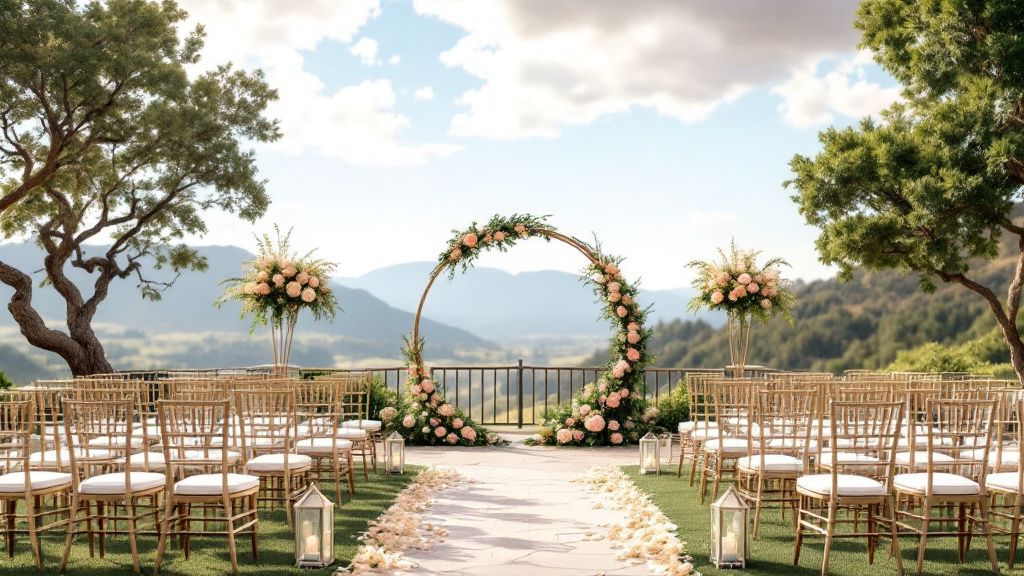
Finding the Perfect Venue
The search for the perfect venue sets the stage for your entire wedding celebration. Begin by envisioning the type of atmosphere you want to create, whether it’s an intimate garden gathering or a grand ballroom affair. Align your choice with your wedding theme and guest list, ensuring the venue can accommodate your needs. A well-chosen venue is foundational to a memorable event and shapes the experiences of you and your guests.
Including venue selection early in your wedding planning checklist is crucial. Reach out to potential venues to understand their availability, pricing, and packages. This information allows you to make informed decisions that fit within your budget and timeline. By securing a venue early, you maintain control over other aspects of wedding planning, including coordination with wedding vendors.
Looking ahead, venue selection is expected to evolve with greater emphasis on personalization and flexibility. Venues will increasingly offer customizable packages to accommodate diverse preferences and themes, further enhancing your ability to execute a unique and personal celebration. This trend underscores the importance of thoroughly researching and booking your venue well in advance.
Integrate wedding photography considerations into your venue choice. Assess lighting, scenery, and architectural features that enhance photographic quality. Share these insights with your photographer, who can suggest creative ways to capture the venue’s charm. This ensures your venue not only serves as a backdrop for your celebration but also contributes to capturing timeless memories.

Choosing Your Wedding Attire
Choosing your wedding attire involves merging style with personal expression, ensuring your ensemble mirrors the theme and formality of your celebration. Begin by reflecting on styles that resonate with you, whether classic, contemporary, or somewhere in between. Schedule fittings early in your wedding planning timeline to accommodate alterations, allowing you to focus on other details closer to the date.
Comparing bespoke wedding attire versus off-the-rack options can guide your decision. Custom designs offer precision in fit and style tailored to your specifications, while ready-made selections provide convenience and potentially lower costs. Understanding these differences helps align your choices with the vision and budget outlined in your wedding planning checklist. This balance guarantees your attire reflects both comfort and aesthetics.
Consult with your wedding vendors for additional insights on coordinating attire. For instance, discuss accessory options with your boutique that compliment your attire style and wedding theme. Similarly, consider how your choices will appear in wedding photography, ensuring every detail is picture-perfect. Thoughtful collaboration with specialists ensures that every piece contributes to breathtaking memories and upholds the day’s aesthetic harmony.
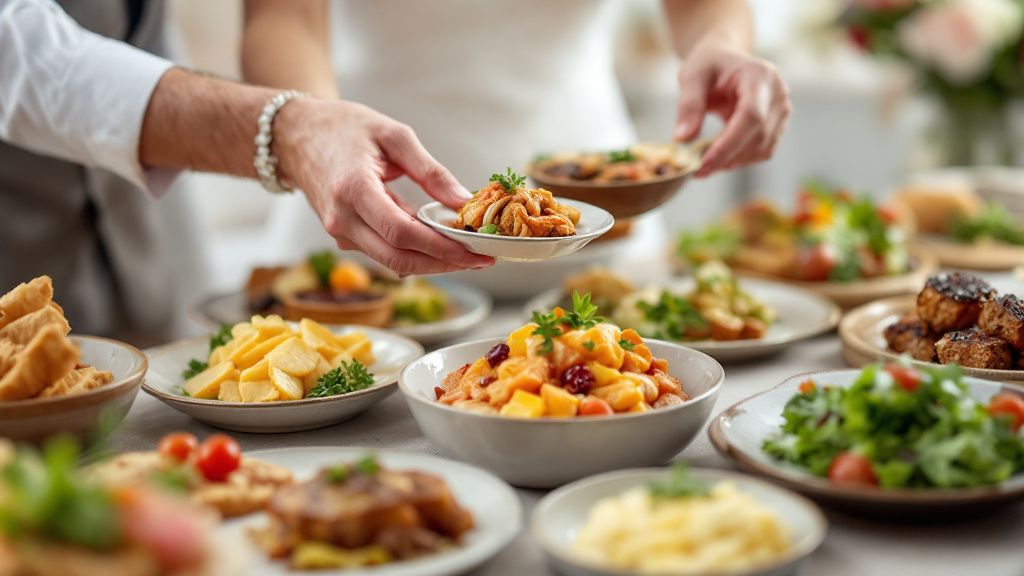
Selecting Catering and Menu Options
Selecting catering and menu options is a reflection of your personal taste and hospitality. Begin by identifying the style of service you’d like, whether it’s a formal sit-down dinner, a buffet, or food stations. Incorporate this decision into your wedding planning checklist, considering guest preferences and dietary restrictions to ensure an inclusive dining experience that delights everyone.
Looking at menu selection through the lens of seasonal and locally-sourced ingredients, we can see that it offers fresher flavors and supports sustainable practices. This approach not only enhances the quality of the dishes but also brings a unique and authentic flair to your celebration. Collaborating with your wedding vendors who specialize in such options ensures this commitment is seamlessly integrated into your event.
Coordinate with your caterers to align the menu with your wedding theme, with attention to detail from hors d’oeuvres to dessert. Discuss presentation styles that complement your event’s aesthetic, potentially adding to the narrative captured in your wedding photography. This thoughtful orchestration of flavors and visuals leaves a lasting impression, making your chosen menu a highlight of your wedding celebration.


